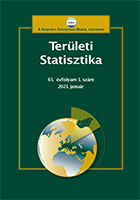A társadalmi újratermelés magyarországi területi egyenlőtlenségei az 1970-es években
Spatial inequalities of social reproduction in Hungary in the 1970s
Author(s): Márton CzirfuszSubject(s): Social Sciences, Economy, Geography, Regional studies
Published by: Központi Statisztikai Hivatal
Keywords: social reproduction; principal component analysis; state socialism; Hungary; settlement
Summary/Abstract: Circumstances and spatial patterns of social reproduction changed significantly during the1970s economic crisis in Hungary. The changes were marked by falling numbers of manufacturing labour in general and upward trends in villages, the strengthening of the second economy and private agricultural production as well as new trends in demographics and housing construction. Based on a political economic approach to social reproduction, the study uses settlement statistics to examine the components of social reproduction in Hungary in the 1970s, which are distinguished by principal component analysis. The model with four principal components distinguished between manufacturing labour, the second economy as well as two principal components of long-term (intergenerational) social reproduction. Principal components showed highly differentiated spatial patterns, implying different mechanisms of spatial organization. The research confirmed several findings of previous regional research on the crisis in Hungary in the 1970s. Contradictory trends were revealed regarding long-term social reproduction: settlements and regions with both better and ‘backward’ positions were showing similarly high factor scores. This fact necessitates further scrutiny and a modification of the concept of social reproduction for the Hungarian state socialist context. Moreover, the analysis revealed significant differences in household-level and settlement-level mechanisms of social reproduction.
Journal: Területi Statisztika
- Issue Year: 60/2020
- Issue No: 06
- Page Range: 634-652
- Page Count: 20
- Language: Hungarian

